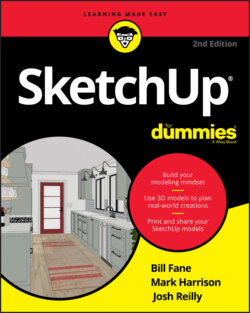Читать книгу SketchUp For Dummies - Mark Harrison - Страница 70
The Materials panel
ОглавлениеThe Materials panel looks different in the Windows and Mac versions of SketchUp, but both versions do basically the same thing. By default, the Materials panel appears on the Default Tray (Windows only). If the panel is ever hidden, and you need to reopen it, choose Window ⇒ Default Tray ⇒ Materials (Mac: Window ⇒ Materials).
In SketchUp, you can choose either of two kinds of materials to apply to the faces in your model:
Colors: These simple colors are always solid colors. You can’t have gradients (one color fades into another), but you can make pretty much any color you want.
Textures: A SketchUp texture is a tiny image that’s tiled to cover a face. If you paint a face with, say, a brick texture, what you’re really doing is telling SketchUp to cover the surface with however many brick-photo tiles it takes to do the job. The preview image you see in the Materials panel is actually a picture of a single texture image tile.SketchUp comes with a whole bunch of textures, and thousands more are for sale online. If that’s still not enough, you can make your own (though the process is well beyond the scope of this humble tome). For details on advanced techniques such as creating a custom texture, check out the SketchUp Help Center (
https://help.sketchup.com).
The following facts about SketchUp materials are also handy to know as you work with them:
Materials can be translucent. Sliding the Opacity slider makes the material you’ve selected more or less translucent, which makes seeing through windows in your model a lot easier. In Windows, you find the Opacity slider on the Edit tab.
Textures can have transparent areas. If you take a look at the materials in the Landscaping, Fencing, and Vegetation library, you’ll notice that a lot of them look kind of strange; they have areas of black that don’t seem right. These black areas are areas of transparency: When you paint a face with one of these textures, you can see through the areas that look black.
There’s a third thing (besides colors and textures) that you can apply to the faces in your models: photos. In fact, photo-texturing is an incredibly important part of some SketchUp workflows. As such, we dedicate a good portion of Chapter 8 to the subject of modeling with photographs.
